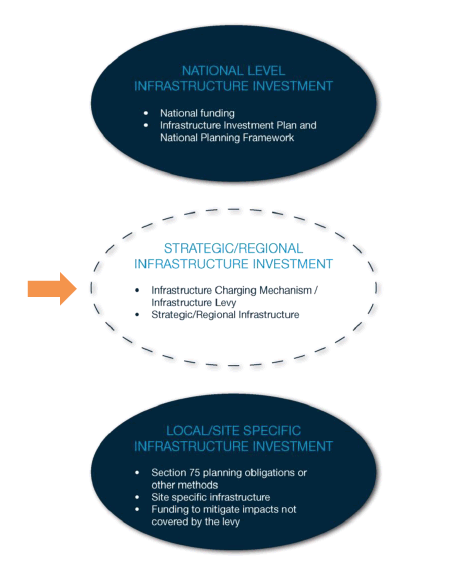Introduction of an Infrastructure Charging Mechanism in Scotland: research project
This research focuses on the options for an infrastructure charging mechanism.
2 Scope of Research
2.1 Introduction
This section outlines the aims and objectives of this research, the scope and the approach and methodology. It also identifies the key elements for consideration, such as geographic scale, Scottish Government policy priorities, land value uplift and legislative requirements.
2.2 Aims and Objectives
The aim of this research project is to identify and assess options for an infrastructure charging mechanism in Scotland to support sustainable economic growth. The research will be used to help inform future decisions on this subject area.
The research objectives are:
| Stage | |
|
| 1 | To identify key priorities for the establishment of an infrastructure charging mechanism within the Scottish context | Completed |
| 2 |
To identify and assess the pros and cons of a charge being applied at different geographical scales | Completed |
| To set out high level options for a charging mechanism, which capture land value uplift, highlight how they meet the identified key priorities and Scottish Government’s policy objectives | Completed | |
| 3 | To critically assess the high level options to identify up to two options and set out a framework for their implementation and operation | This Stage |
This report addresses the final objective, namely critically assessing high level options to identify options for an infrastructure charging mechanism, and setting out a framework for their implementation and operation. This Report should be read in conjunction with the Stage 1 & 2 report.
2.3 Key Elements for Consideration
The key elements for consideration in Stages 1 and 2 of this research project included:
| Key Element | Detail |
|---|---|
| Geographic Scale | To consider the options of a charge being applied at different geographic scales, for example, sub Local Authority, Local Authority, Regional or National level. An important factor for any charge will be the ability to address cross-boundary infrastructure requirements. To consider what flexibility should be applied to the implementation of the mechanism within and across these levels. |
| Scottish Government Policy Priorities | To consider the implications of the different geographic options for Scottish Government national policy objectives. |
| Land Value Uplift | To consider how the charging mechanism will be applied to capture land value uplift. |
| Development Plans | To consider the relationship between the charging mechanism and Development Plans / the Development Plan process, taking account of the need for flexibility to integrate with a changing Development Plan landscape. To consider the relationship between a potential infrastructure charging mechanism, with other developer contribution requirements e.g. affordable housing. |
| Legislative Requirements | To set out the broad scope for legislative requirements at the identified geographic levels. |
| Optional/Compulsory | What approach should be taken to the adoption of a charge, for example, optional/compulsory and what would the implications of this be? |
| Relationship to Development Management and S.75 / Legal Agreements |
How would any infrastructure charging mechanism relate to the use of existing mechanisms for securing contributions, including use of planning conditions and legal agreements including S.75? What changes to S.75 of the Planning Act would be required to accompany each of the options to ensure developers are not ‘double charged’ for infrastructure? |
| Implementation/Resources | To consider options for where responsibility would lie for setting, applying/implementing and managing the charge at the different scales? What level of political support would be required? What form of Project Management / structure would be needed within the relevant organisations to ensure the process is transparent and efficient? To appraise the resource and skills implications for the relevant sectors. |
| State Aid | To consider the implications of State Aid for the identified options and how to address this. |
2.4 Research Stage 3
The research for Stage 3 synthesises outputs from Stage 1 and Stage 2, and consults further on the identified ‘high level options’. It develops a methodology to assess the options and develops a framework for these. Following from the priorities and high level options set out in Stages 1 and 2, it aims to identify potential mechanisms to apply to a ‘middle tier’ between national infrastructure investment and local, site specific infrastructure ( Figure 2.1 ).
Figure 2.1 Hierarchy of infrastructure investment

The following outlines the key tasks undertaken to meet the aims and objectives of Stage 3 of the research project:
| Stage | Tasks |
|---|---|
| Stage 3 | To identify and prepare a case for the shortlisted options and develop a framework for those options that best meet the key priorities for a potential charging mechanism. To develop a framework to elaborate detailed process elements, including calculating and applying the charge and delivery of the preferred mechanism options. To set out a timeline for the preparation of the charge. To incorporate relevant responses from the Planning Review taken forward following completion of the consultation process. To specify client meeting dates at the beginning of the Stage 3 work programme, including key stakeholders such as the Scottish Government and Scottish Futures Trust. |
This report represents the output of Stage 3 and is to be taken forward by the Planning and Architecture Division of Scottish Government for consideration as part of the drafting of the Planning Bill process. The first report contains the output of Stages 1 and 2 (December 2016), and the Executive Summary will link the output of this Stage 3 Report with the previous two stages.
Contact
There is a problem
Thanks for your feedback